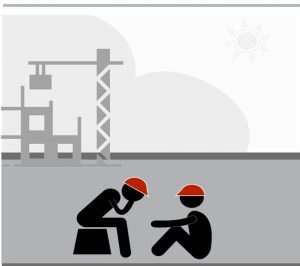First published by Safety+Health an NSC publication
Image from CPWR
Silver Spring, MD — Symptoms of anxiety and depression among construction workers have worsened during the COVID-19 pandemic, especially among women and workers living in poverty, according to a new report from CPWR – The Center for Construction Research and Training.
Anxiety and depression are of particular importance in the construction industry, CPWR notes, citing a 2020 Centers for Disease Control and Prevention study that concluded male construction workers have one of the highest suicide rates among all industries and are at four times greater risk than the general public.
Using 2011-2018 and 2020 data from the National Health Interview Survey, researchers examined self-reported symptoms of anxiety and depression among construction workers to uncover any potential patterns and changes amid the pandemic. During the time frame prior to the pandemic, the number of construction workers who reported feeling anxious at least once a month rose 20%.
Among a subset of nearly 1,300 construction workers who were surveyed in both 2019 and 2020, 43% reported a rise in the level or frequency of anxiety/depression feelings between the two years. Those increased feelings were most prevalent among workers whose family incomes were below the poverty line (61%), female workers (50%) and those ages 18-54 (46%).
The 2020 data shows that symptoms of or medication use for anxiety/depression were nearly three times higher for workers who used prescription opioids in the past year (39%) compared with those who did not (14%).
Construction employers can act by sharing resources with their workers. CPWR offers resources on suicide prevention and preventing opioid deaths, while NIOSH has a webpage on stress at work.
McCraren Compliance offers many opportunities in safety training to help circumvent accidents. Please take a moment to visit our calendar of classes to see what we can do to help your safety measures from training to consulting.
